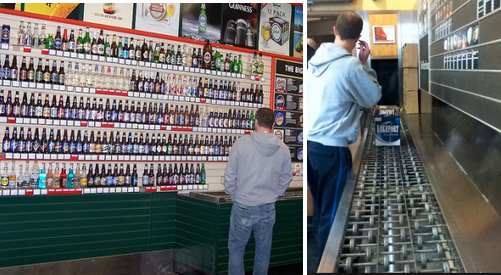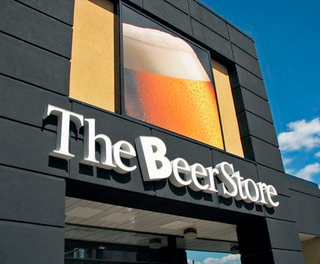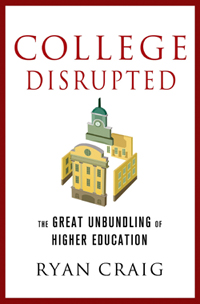Volume V, #7
Doug McKenzie: Like how many beers would that be, if you want like, a six pack in metric?
Bob McKenzie: Six, six is 12, 30 is 42 beers. 42 metric beers.
Doug McKenzie: That's good for me, eh? Count me in on metric.
- From The Great White North
If there’s one place you’d think it would be easy to buy beer, it would be the home of Bob and Doug McKenzie: Ontario, Canada’s largest province. But having grown up in Ontario, I can assure you this is not the case. (So, American friends, add this to your list of misconceptions about Canadians – a very long list as far as Canadians are concerned. But a list that doesn’t exist as far as Americans are concerned, which explains why the list of Canadian misconceptions about Americans numbers only one item: namely, that Americans think about Canadians at all.)

Many of my adolescent memories are of being extremely cold, loitering with friends outdoors trying to find someone willing to buy us a case of beer. In Ontario, though, it didn’t pay to loiter outside of just any store. Only two stores sold beer: the provincial government operated Liquor Control Board of Ontario (LCBO) stores, which sold spirits, wine and beer, and another chain called The Beer Store – a tribute to that uniquely Canadian flair for language that best manifested itself in the fact that two of the eight franchises in the old Canadian Football League shared the same name: The Saskatchewan Roughriders and the Ottawa Rough Riders.
I didn’t realize it at the time, but The Beer Store is also a tribute to Canadians’ trust in government. A result of post-Prohibition rules on beer sales, The Beer Store has a government monopoly on beer sales on Ontario – its 466 stores accounting for 80% of Ontario beer sales. No private retailers are permitted to sell beer.
The experience of buying beer at The Beer Store is unsettling. The store has no apparent merchandise, only a wall display of hundreds of beer bottles. Shoppers place their orders, which are conveyed to a windowless warehouse attached to the store. The beer then appears out of a hole in the wall and clatters down a steel roller conveyor belt. One Canadian independent brewer recently quoted in the New York Times, said “I’m trying to come up with an analogy that doesn’t talk about communism, Russia. Well, it wouldn’t be a consumer experience consistent with the 21st century.”

Defenders of the system tout the low-cost, no-frills model. After all, Bob and Doug McKenzie don’t need frills. They just need beer. “Truth be told, it is a highly cost efficient model for consumers,” said a Beer Store spokesman. “I know what’s best for consumers. And having seen a wide range of retailing across the world, I can tell you that this is a system that is low cost and passes that cost along to consumers.”
Which might be fine except for two things. First, it’s not actually low cost. According to the the New York Times: “Ontario doesn’t have many beer bargains, particularly on imported beer. A case of 24 bottles of Stella Artois… sells for $47.95 Canadian [in Ontario vs. ] $36.65 Canadian [in Quebec].” Second, The Beer Store is actually owned by three of the world’s largest breweries – AnheuserBusch InBev, Molson Coors and Sapporo – which include Canada’s two largest firms, Labatt’s and Molson. And that spokesman for The Beer Store I mentioned? That’s the CEO of Molson Coors Canada.

So the Beer Store doesn’t make it easy for microbrewers to access the market. It charges brewers $2,800 for each new item plus $230 for each store. Not surprisingly, small breweries account for less than 6% of the Ontario market (vs. 12% in British Columbia).
When The Beer Store, originally called Brewers Retail, received its government monopoly, it was a cooperative of local Ontario brewers. So what seemed like a good idea at the time has become problematic now that the industry subject to regulated distribution has effectively captured the distribution. “If there’s a monopoly,” points out Darren Smith, President of Lake of Bays Brewing in Baysville, Ontario, “there should be some public good.”
***
Bluto (to Flounder, upset about wrecked car): My advice to you is to start drinking heavily.
Otter: You better listen to him, Flounder. He's in pre-med.
- From Animal House
For many, beer and college are as inextricably linked as The Captain and Tenille. As I’ve visited a number of institutions of higher learning that would pass muster with Beer Store officials (i.e., consumer experience inconsistent with 21st century, view that they know what’s best for consumers, belief that they operate in a low-cost manner and pass that cost along to consumers), it’s natural to ask if regulatory capture has contributed to the current higher education landscape.
In 1971, University of Chicago economist George Stigler published “The Theory of Economic Regulation” in the Bell Journal of Economics and Management Science. The article reported and summarized empirical data from various industries and concluded that, “as a rule, regulation is acquired by the industry and is designed and operated primarily for its benefit.”
Unlike financial services, pharmaceuticals and utilities, higher education hasn’t been a focus of research on this phenomenon. In higher education, at the federal level, “regulators” would include the Department of Education (ED) and ED recognized accrediting bodies. Based on the literature of regulatory capture from other industries, here are some warning signs:
1. Regulators don’t ask big questions like what products/services best serve consumers, what outcomes should be expected, what price levels are necessary to achieve those outcomes?
2. Regulators employ procedures that emphasize industry/company positions over public interest perspective.
3. Revolving door of personnel from industry to regulator.
There’s no question that President Obama’s Department of Education has asked some big questions. Questions like, at the dawn of competency-based learning, should we require Title IV to be based on the 100-year-old Carnegie Unit? (Apparently yes.) Should we impose tighter regulation on for-profits? (Clearly.) And should we balkanize our national market for online learning by requiring state authorization? (Also yes.) To be fair, ED has also asked questions like are colleges and universities doing as much as possible to encourage lower income students to apply and matriculate? And now whether ED should produce a college ratings system? (The answer may well be no. One is not enough. ED should produce two separate ratings systems.)
Big though these questions are, there are bigger, more important questions ED should be asking: Does the current system of degrees and certificate programs produce an adequate return on investment for students and the nation? What data are colleges and universities producing and tracking to measure outcomes? And are accrediting bodies measuring the right things when they accredit and reaccredit institutions?
For their part, accreditors could be suspected of regulatory capture. Both the commissions and visiting teams of accrediting bodies consist exclusively of sitting officers and managers at regulated colleges and universities. And the procedures employed by accreditors are oriented entirely around specific positions (e.g., demonstrate why your institution merits reaccreditation) rather than taking a broader perspective.
Andrew Kelly at the American Enterprise Institute has identified regulatory capture as a factor impeding innovation in higher education. He points to the creation of Western Governors University – a truly innovative institution – and asks whether it should take 19 governors and a new federal law to create one innovative institution? (If he’s wrong, where are the new Western Governors Universities? And I don’t mean the mini-WGUs in Indiana, Missouri, Tennessee, Texas and Washington.) Western Governors may well be the exception that proves the rule.
***
Back in the world of beer, The Beer Store says it’s trying to improve the customer experience by putting iPads on the walls and actual cases of beer in the stores. But that hasn’t dissuaded the Ontario government, facing a $12.5B deficit, from proposing to auction off licenses to sell beer in supermarkets.
It shouldn’t take a crisis to move higher education beyond reproach with regard to regulatory capture. Fortunately, we’re seeing some movement now. This week, NACIQI, the so-called accreditor of accreditors, suggested “a need for a more differentiated process… more transparency and openness in the accreditation and the recognition process, and a greater emphasis on student achievement and student outcomes.” Also this week, Senator Lamar Alexander, Chairman of the Senate HELP Committee, released three papers floating ideas for the next reauthorization of the Higher Education Act. The papers called for more gradations in accreditation status and the establishment of new, nontraditional accreditation agencies.
While Canadians may not have figured out how to sell beer, the active role played by provincial ministries of education in overseeing higher education demonstrates they’ve worked out the college part. And if Bob and Doug McKenzie can figure this out, we can too.
University Ventures (UV) is the premier investment firm focused exclusively on the global higher education sector. UV pursues a differentiated strategy of ‘innovation from within’. By partnering with top-tier universities and colleges, and then strategically directing private capital to develop programs of exceptional quality that address major economic and social needs, UV is setting new standards for student outcomes and advancing the development of the next generation of colleges and universities on a global scale.

 College Disrupted: The Great Unbundling of Higher Education
Buy the book now at Amazon
College Disrupted: The Great Unbundling of Higher Education
Buy the book now at Amazon
“[Full of] unnecessary stories about pranks he pulled as a Yale undergraduate.”
- Janet Napolitano, President of the the University of California
Comments